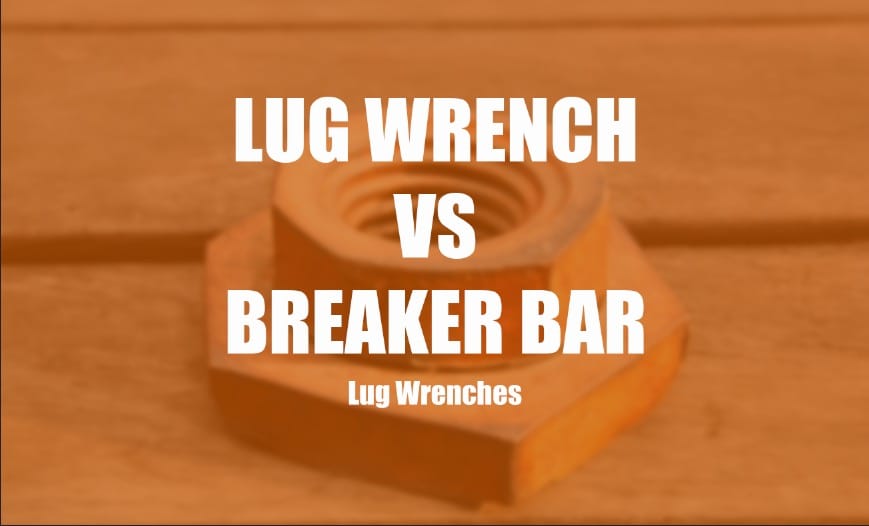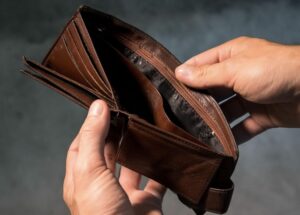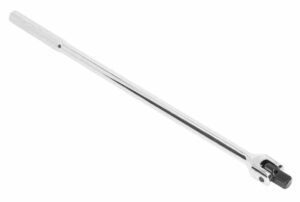Are you struggling to find a good resource to understand the differences between a lug wrench and a breaker bar?
Well, that probably happens because there isn’t a complete guide that properly compares lug wrenches vs breaker bars to teach readers what would be the best tool for them.
This is why I decided to create this article where I will be building a full comparison between lug wrenches and breaker bars to hopefully teach you a thing or two about these two amazing manual tools.
Let’s get started.
What’s a Lug Wrench
A lug wrench might seem like a small, unassuming tool, but it’s actually a lifesaver for a lot of people.
I mean, a lug wrench is a key tool essential to loosening and tightening the lug nuts that keep a car’s wheels securely in place.
They come in many shapes and sizes, but the most common type is the trusty cross-shaped that’s very easy to use and essential to providing the leverage needed to easily loosen or tighten lug nuts.
And unlike some heavy-duty tools (I’m looking at you, breaker bars), lug wrenches are light and compact, making them the perfect on-the-go tool for any vehicle owner. Simply toss one in your trunk and you’ll be prepared for any tire-related emergency.
Of course, nothing is perfect and lug wrenches have their limitations too.
For instance, if your lug nuts are particularly tight or rusted, the limited leverage of a lug wrench might not cut it. For those situations, options like breaker bars or impact wrenches exist as they can give you the extra torque you need.
What’s a Breaker Bar
Have you ever been in the middle of a job and found yourself struggling to loosen a tough nut or bolt without any light at the end of the tunnel?
That’s where a breaker bar comes in – it’s one of the big dogs of the wrenching world as it provides the torque necessary to deal with most rusty and stubborn fasteners.
A breaker bar is essentially a ratchet wrench with a longer handle, allowing you to bring the heat and apply more leverage and torque to any fastener that dares to stand in your way.
What makes breaker bars unique? Well, I’d say it’s the extra leverage that comes with its long handle which gives more torque to work with, and a better shot at loosening those stubborn fasteners that have been causing you trouble.
And with most breaker bars being made from tough, durable materials such as steel, chrome-vanadium steel, and titanium, you can count on them to last job after job.
Of course, no tool is perfect, and breaker bars do have a few drawbacks such as the fact that it’s a bit bulkier than a regular lug wrench, which can make storage a bit of a challenge.
Also, if you’re working in tight spaces, a breaker bar might not be the most convenient option due to its already-mentioned longer handle that makes it a bit difficult to store.
Lug Wrench vs Breaker Bar
Let’s begin by comparing both tools from the following five aspects, which will give you a good perspective on what makes each tool unique:
Purpose
If you’re a seasoned tradesman, you know that having the right tools for the job is crucial which is why you may be wondering whether to go with a lug wrench or a breaker bar.
A lug wrench is a compact and convenient tool that is specifically designed to loosen or tighten lug nuts on your vehicle’s wheels making it a great tool for quick and simple jobs where you don’t need a lot of torque.
Think of a time when you needed to change a tire on the side of the road, a lug wrench would have been your best friend!
On the other hand, a breaker bar is your go-to tool when you need to apply some extra torque to break loose stubborn fasteners.
Picture this: you’re under the hood of your car, trying to remove a stubborn bolt, and your ratchet just isn’t cutting it. That’s when you reach for your trusty breaker bar as it has a longer handle which allows it to deliver more leverage and torque to get the job done.
Design
The design of a lug wrench is T-shaped or cross-shaped with a socket on each end made to handle the lug nuts on a vehicle’s wheels with ease.
This design makes them shorter in length, allowing them to be portable and perfect for quick and simple jobs.
A breaker bar, on the other hand, is a longer, straight bar with a socket attached to one end.
Their design allows for more torque to apply to stubborn nuts and bolts that don’t want to come out. In fact, the longer handle on a breaker bar increases leverage which is the key for this tool as it is what allows the tool to deliver more torque.
Torque
When it comes to tools, torque is key as with the right amount of torque, you can make your job faster and easier.
In that context, a breaker bar is a winner as it provides more torque than a lug wrench.
This is due to its long handle and sturdier construction, which allows it to apply more force to a fastener.
For example, a breaker bar with a 24-inch handle can provide up to three times more torque than a lug wrench with a 12-inch handle. That’s some serious leverage!
Lug wrenches, on the other hand, are designed specifically for loosening and tightening lug nuts on a vehicle’s wheels.
They may not provide enough torque for stubborn or rusty nuts and bolts, but they get the job done when it comes to the regular lug nuts you’d find in a car’s wheel.
Price
Tools can be expensive, especially for tradesmen who need a wide range of them for different jobs. That’s why it’s essential to get one that is both affordable and highly useful.
The good news is that both lug wrenches and breaker bars are fairly afforable.
When it comes to lug wrenches, the price range can vary depending on the type and material of the wrench.
A basic steel lug wrench can cost anywhere from a few dollars to around $20, while higher-end models made from aluminum or more durable materials can cost anywhere from $20 to $50 or more.
Breaker bars also have a similarly wide price range, with basic models starting at around $10 to $30 and higher-end models costing anywhere from $30 to $100 or more.
Versatility
When it comes to tools, versatility is key for tradesmen who need to be prepared for any job that comes their way.
For instance, if you’re a mechanic, you don’t want to be stuck with a tool that can only handle one type of fastener.
And this is where breaker bars shine as they are designed for a wider range of applications, from breaking loose stubborn fasteners to dealing with lug nuts on a car’s wheel, offering superior versatility.
Lug wrenches, on the other hand, are specifically designed for a car wheel’s lug nuts and may not provide enough leverage for other types of fasteners.
And, while they are great for their intended purpose, they are not as versatile as breaker bars, making them a less practical choice for those in need of a multi-functional tool.
Benefits of Lug Wrench
Here are the main benefits of getting a lug wrench:
Portability
Carrying around heavy and bulky tools can be quite a hassle, especially when you’re always on the move.
The good news is that lug wrenches won’t add to this issue as they’re fairly portable!
This is possible thanks to their simple and lightweight cross T designs, which is easy to store and transport
I mean, they are easy to store in a vehicle and carry with you wherever you go, what more could you ask?
Affordability
As a tradesman, saving money is a top priority, especially when it comes to taking care of your family.
Compared to other types of wrenches, lug wrenches are affordable and readily available at most automotive supply stores.
I mean, they usually don’t cost more than $50 dollars and they can become an essential part of your toolbox very quickly!
So, not only are you getting a handy tool, but you’re also saving yourself some money in the process.
Easier to Use
Most tools, particularly breaker bars, require a lot of physical force to be used or can be too complicated.
But, lug wrenches are designed with a simple design that is easy to use, even for those who don’t have mechanical experience.
I mean, you just need to fit the lug wrench’s socket snugly over the lug nuts you want to remove or fasten, and then the handle will provide the leverage you need to tighten or loosen them.
Cons of Lug Wrench
It’s not everything amazing when it comes to lug wrenches. In fact, there are some clear disadvantages related to getting these tools, such as:
Less Torque
Torque is a crucial factor when it comes to wrenches. I mean, a tool that provides a weak torque can make removing stubborn bolts a frustrating experience as it won’t take them out of place.
Unfortunately, lug wrenches do provide less torque, which makes them not suitable for removing stubborn bolts that are commonly found both in cars and trucks.
A lug wrench’s compact design limits the amount of torque that can be generated when using the wrench, which is why they are known to be engineered only to loosen and tighten lug nuts which don’t require a lot of torque instead of removing stubborn nuts and bolts.
This can slow down productivity, making the job of removing fasteners take longer and very frustrating.
Not for Intensive Tasks
There are times when you need a tool that can help you fasten or remove a car’s wheel’s lug nuts, as well as remove stubborn or rusted nuts or bolts.
Unfortunately, lug wrenches aren’t designed for the latter as they don’t provide enough torque when used, due to their smaller and more compact design.
So, if you’re looking for a tool that could do both, a lug wrench is not your best bet.
Benefits of Breaker Bar
When you get a breaker bar, there are three solid main advantages that make them an awesome tool:
More Torque
When it comes to removing stubborn bolts, torque is essential as the more torque you have, the more force you can apply, and the more likely you are to break those stubborn bolts loose.
With a breaker bar, you have the power to do exactly that, thanks to its longer handle design that gives its owners that chance to create more torque.
And, unlike lug wrenches, which are limited to wheel lug nuts, breaker bars can be used with any type of nut and bolt, making them not only more powerful but also more versatile tools.
Suitable for Heavier Tasks
With their ability to provide more leverage and torque, they are the perfect tool for those jobs that require a little extra muscle.
Imagine trying to loosen a bolt that’s been stuck for years, you can try all the tricks in the book, but sometimes you just need a little extra torque and that’s where a breaker bar becomes essential.
These hand tools are built to output high torque levels, so you can put all your strength into breaking those stubborn nuts and bolts loose.
And unlike smaller tools, the breaker bar won’t break easily even if you put all your physical strength into it, so you can count on it to get the job done every time.
More Leverage
With its longer handle, the breaker bar provides more leverage, making it easier to apply force to stubborn bolts.
What do I mean with leverage?
Well, leverage refers to the mechanical advantage gained from using a longer tool to apply force to an object. In the case of a breaker bar, the longer handle allows the user to apply more force with less effort, making it easier to loosen stubborn bolts and nuts.
Cons of Breaker Bar
Getting a breaker bar also has its disadvantages, here are the most serious ones:
Bulkier and Heavier
While the breaker bar is incredibly useful for a wide range of tasks, its bulk and weight can be a drawback.
I mean, carrying a breaker bar can be especially challenging as these tools are typically larger and heavier than lug wrenches, making them less convenient for moving around the worksite.
They also take up more storage space in your vehicle or toolbox.
That being said, compared to power tools, breaker bars are still fairly portable, especially when you put them next to an impact wrench, so take that in mind.
Harder to Use
Breaker bars are designed to apply more torque to fasteners than a standard ratchet wrench, but that extra power comes at a cost.
They may require more experience to use effectively which is why I’d say that if you’re not used to working with tools, the breaker bar can be a little intimidating.
In addition, breaker bars are typically larger and heavier than lug wrenches, and the shape of the tool can make it difficult to use in tight spaces, which is another drawback worth mentioning.
Comparison Table
| Lug Wrench | Breaker Bar | |
| Purpose | Fastening/Removing lug nuts on car wheels | Fastening/Removing any kind of stubborn nut or bolt |
| Design | T-shape | Straight bar |
| Torque | Weak torque | High torque |
| Price | Affordable | Affordable |
| Versatility | Only for lug nuts | For all kinds of stubborn nuts and bolts |
Frequently Asked Questions
Here are some of the most frequent questions related to the comparison between lug wrenches and breaker bars. Let’s give it a shot and try to answer all of them.
Are breaker bars good for lug nuts?
Yes, breaker bars are great for removing and fastening lug nuts.
These handy tools are simple to use and pack a powerful torque, making them the perfect choice for loosening stubborn nuts.
And the best part? They won’t break the bank! S
o, whether you’re changing a tire or performing routine maintenance on your vehicle, a breaker bar is a must-have tool in your arsenal.
Why would you use a breaker bar instead of a lug wrench?
When it comes to tough or rusty nuts and bolts, a standard lug wrench just won’t cut it which is why experienced tradesmen turn to breaker bars.
These tools boast longer handles, providing increased leverage to make loosening stubborn nuts something easy.
Also, it’s worth noting that lug wrenches are designed specifically for car wheel lug nuts, and may not be suitable for other applications, which is also why breaker bars are more versatile.
Can I use a socket wrench as a breaker bar?
Yes, you can use a socket wrench as a breaker bar as both are capable of removing and fastening nuts and bolts.
You just have to attach a longer handle to your socket wrench, and voila! You’ve got yourself a breaker bar.




